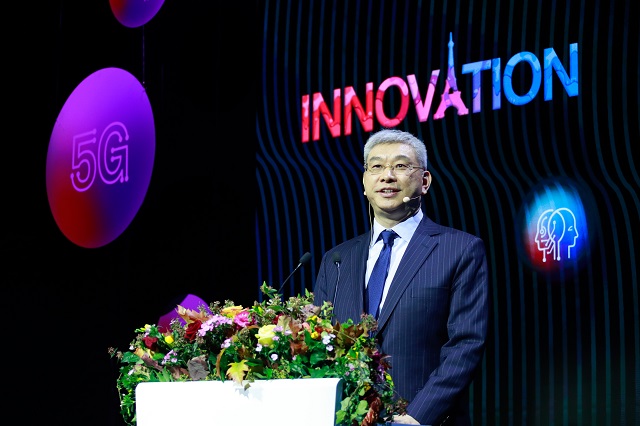Huawei has emphasised its commitment to the European market at its Innovation Day and eco-Connect Europe events held in Paris, France this week, writes George Malim. The company revealed research from Oxford Economics that totals its contribution to the European economy as €12.8bn per year, taking into account direct contributions through its 13,300 employees in the region, taxation and its €6.6bn spending in Europe plus the spending and taxation of those employed in its supply chain.
Huawei has been active in Europe for almost 20 years, selling fixed and wireless network equipment, telecoms software, mobile devices and, more recently, ICT services throughout the region. However, the company is finding its growth in the US blocked by the Trump administration and is therefore keen to detail its performance in the rest of the world.
“External pressures will not crush Huawei, instead they will make us stronger,” said William Xu, a director of the board at Huawei and president of the company’s Institute of Strategic Research. “We are entering an intelligent world, with three features, all things sensing, all things connected and all things intelligent. Thanks to big data and artificial intelligence we will realise all things intelligent.”
“In the past we’ve focused on physical boundaries and digital sovereignty requirements but this doesn’t mean building a new Berlin Wall across the digital world,” added Xu. “The EU will launch its digital Europe programme and we will focus on super-computing, AI and ensuring we can have wide access to digital technology.”
Josianne Cutajar, an MEP and member of the parliament’s European ITRE committee on industry, research and energy, looked forward to a Europe that is technically open but also secure for its citizens. “I look around me and see conflicts – a climate that is changing and a planet that is dying,” she said. “Instead of opening up doors some choose to close them. [Data] sovereignty means authority, it also means knowledge and I envisage Europe no longer as a follower but a prime leader. We have to find the right balance between openness and protection.”
Naturally, 5G was also high on the agenda, with European operators rolling out Huawei network equipment and many organisations collaborating with the company to develop 5G-based solutions for connected cars, industry, cities and homes. “Thanks to President Trump, everyone knows Huawei is the leader in 5G today,” commented Yan Lida, the president of the enterprise business group at Huawei, with a smile. “We’ve posted 24% year-on-year growth in the first three quarters of this year so we are doing OK but I know we will not be able to survive without partners, customers and friends who stay with us.”
Dr Zhou Hong, the president of Huawei’s European Research Institute, said that the company has collaborated with BMW, VW and Audi since 2013 on the future of autonomous driving and that 5G can enable latency of less than a millisecond, enabling decision making to be taken more rapidly than can be done by a human being. “On the highway that enables reducing the distance between vehicles at 100kmh from 48 metres to five metres,” he said.
Merouane Debbah, the director of the Mathematical and Algorithmic Sciences Lab at Huawei, looked further into a future beyond even 5G. “In a scenario for days beyond 5G, the data rate will exceed 1Tbps and the digital industry and robotics will need latency of less than one microsecond,” he said. “By 2030 we’ll achieve the target of a fully connected, intelligent world with a data rate of 1Tbps, jitter of 0.1 millisecond and GPS with high accuracy to within 10cm. We will be able to configure IoT cover more things with connectivity density of ten devices per square metre. This isn’t here yet but it will be with 5G++ in the period 2024-2028 and 6G arriving 2028-2030.”
Xu also pointed out that the current cycle of innovation is coming to an end and new inventions are needed. He put forward the idea of Innovation 2.0, detailing that the traditional rules of Shannon’s Law and Moore’s Law are breaking down and new theoretical replacements are required. These will come from academia and research and development efforts, he said.
“The breakthroughs are highly uncertain so innovation must be open and development inclusive,” he added. “Industries should work with others to enable collaboration and the goal of Huawei Institute of Strategic Research is to make this happen. When Moore’s Law fails, heterogeneous computing will allow us to keep advancing, photonic computing will make data processing hundreds of times faster. Think of DNA storage. One kilo of DNA can accommodate most of the data in the world today.”
“Technology is a shared wealth for all human beings, it knows no national borders,” he continued. “Huawei will use its leading technologies and become a key enabler of digital transformation of Europe to drive digital adaptation.”






